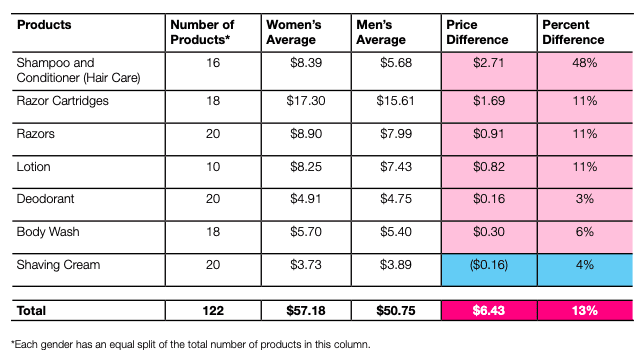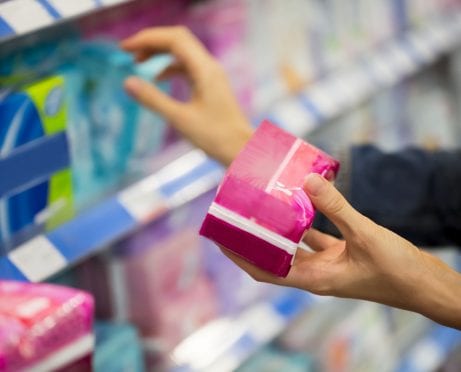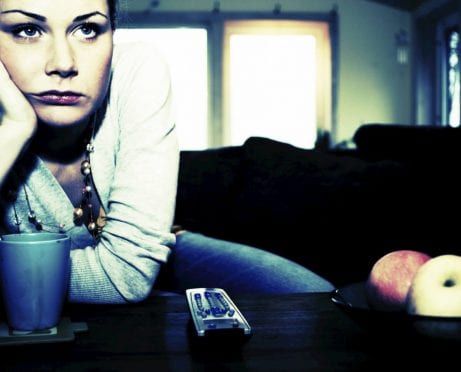
There are certain times of the month when you may start to feel a little fatigued, become a tad more emotional, and endure some cramps. Sounds familiar? The ladies know what I’m talking about.
Your period can put you on an emotional and physical roller coaster, but have you ever thought about how much your period is actually costing you? In real dollars? This is one of the many costs that gets wrapped up in the “pink tax.”
Sign Up for an Investing Service That Empowers Women — Get Started >>
 So, What Is the Pink Tax, Exactly?
So, What Is the Pink Tax, Exactly?
Consider the fact that every single month, you need to go out and purchase “feminine hygiene products.” (Is anyone else slightly insulted by this term?)
Whether it’s pads, tampons, cups, or even fancy panties specifically designed for your period, you have to spend money. When you consider the “extra” costs that can accompany your cycle — pain relievers, foods you may crave, and new underwear (because let’s face it, accidents happen) — you’re spending a good amount of money every month just to endure your own anatomical reality.
Women typically get their period from age 12 to age 50. That’s nearly four decades of spending money each month on something that is completely natural.
What’s worse is that women pay more for everyday products than you even realize.
Currently, a majority of states charge sales tax on tampons. The decision to tax personal care products falls to the state and local tax authority. Some waive sales tax on things you need to survive, such as food (California) and medication (most states). However, there are others that don't (Idaho taxes food). It’s not just feminine hygiene products that are taxed. Other products geared toward women are taxed, as well, or else get marked up compared to men's products.
The pink tax is real and in full force. Items such as razors, deodorant, perfume, and more all cost more than the very same products geared toward men.
Sign Up for an Investing Service That Empowers Women — Get Started >>
The Cost of Women’s Products vs. Men’s

The Cost of Being a Female Consumer”
Women pay seven percent more for their products than men do, according to a 2015 report conducted and led by New York City’s Department of Consumer Affairs. The study also found that women’s products cost more 42 percent of the time and men’s products cost more only 18 percent of the time.
“In all but five of the 35 product categories analyzed, products for female consumers were priced higher than those for male consumers,” the study reports. Girls' toys and clothing and women’s personal care products and clothing suffered the most in terms of price inflation.
The study found that women essentially paid a “gender tax” of approximately $1,351 annually for the same services as men.
Couple that with the fact that women typically earn 82 cents for every dollar a man makes, and it’s a pretty infuriating situation. This clearly isn't always the case, but it's still a real trend.
Whose Fault Is This?
Though there are several legitimate factors that can be considered when figuring out retail price for items marketed toward women, it falls to the distributor to fairly price these items.
“Individual consumers do not have control over the textiles or ingredients used in the products marketed to them and must make purchasing choices based only on what is available in the marketplace,” says Iskra Tsenkova, CEO and founder of Angel Shave Club, a boutique subscription shave club. “As such, choices made by manufacturers and retailers result in a greater financial burden for female consumers than for male consumers.”
Unfortunately, it is primarily in the hands of manufacturers and distributors to price “pink” items appropriately.
So What Can Women Do About the Pink Tax?
The situation pisses many people off, but what can we do to combat gender-biased pricing?
For starters, when you go shopping, compare prices between products geared toward men and women. And second, consider buying your feminine hygiene products in bulk so you can save money.
Next up, you can actually sign a Change.org petition to end the tampon tax. The recent conversation is helping. Several states are already considering ending the tampon tax. Some New York City schools are proposing to offer free tampons and pads. In addition, some companies are offering “period leave” for those whose cycles actually get in the way of their work (totally been there).
Call in or email your state legislators to let them know if you feel strongly about this issue. Getting legislators to waive the sales tax on feminine items could be tough in states where legislators are unwilling to waive sales tax on food. It might be even more difficult where they collect taxes on doctor prescribed medications. But all the same, it’s better than leaving it in the hands of corporations and retailers.
As women, it can often feel like we are getting the short end of the stick. We're paying more for products and earning less. Frankly, it sucks. But there are small things you can do as a consumer, such as being informed. That and taking action to help end this inequality.










